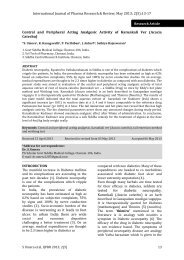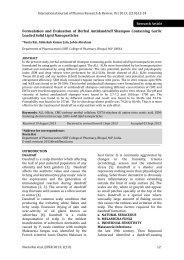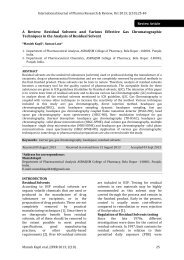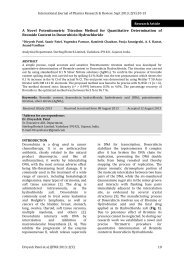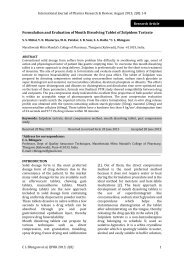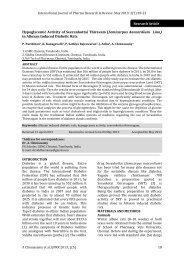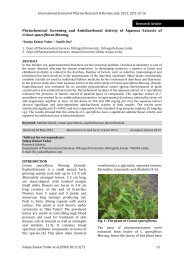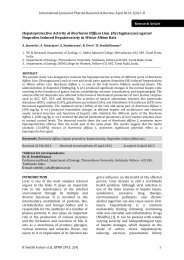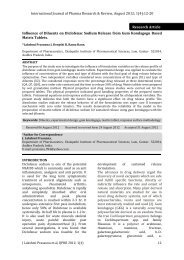Novel Approaches for Brain Drug Delivery System-Review
Novel Approaches for Brain Drug Delivery System-Review
Novel Approaches for Brain Drug Delivery System-Review
- No tags were found...
Create successful ePaper yourself
Turn your PDF publications into a flip-book with our unique Google optimized e-Paper software.
International Journal of Pharma Research & <strong>Review</strong>, June 2013; 2(6):36-44 ISSN: 2278-6074using a transferrinconjugated PEGmodifiedPAMAM dendrimer [37].Peptide-Vector-Mediated StrategyThe other approach <strong>for</strong> the delivery ofneuropharmaceuticals is the use of smallnaturally derived peptides that crosscellular membranes efficiently, <strong>for</strong> example,pegelin and penetratin peptides (18 and 16amino acids, respectively). SynB1 andpegelin(RGGRLSYSRRRFSTSTGR;molecular mass 2099 Da) is derived fromnatural peptides called protegrins. Theyhave an amphipathic structure in which thepositively charged and hydrophobicresidues are separated in the sequence.Replacement of the four cysteine residueswith serine residues leads to linear peptides(pegelin). The potential of this approach asan effective delivery system <strong>for</strong>transporting drugs across the BBB has beendemonstrated in animal models [38].<strong>Novel</strong> MethodsThe challenging domain of effective braindelivery has led to a keen scientific pursuitand as a result many novel methods havebeen invented and patented. In these series,researchers have revealed the use ofiontophoresis as an adjuvant <strong>for</strong> CNS drugdelivery. Iontophoresis has been defined asthe active introduction of ionised moleculesinto tissues by means of an electric current.The parent US patent method and device<strong>for</strong> delivery of a biologically active agentthat is transported by means ofiontophoresis and/or phonophoresisdirectly to the CNS using the olfactorypathway to the brain and thereby circumventingthe BBB and is known as transnasaliontophoretic delivery [39].Molecular Trojan HorsesEndogenous ligands <strong>for</strong> specific BBBreceptors, also known as Trojan horses,have the capacity to shuttle drugs into thebrain.Vasoactive intestinal polypeptide(VIP) participates in the regulation ofcerebral blood flow; however, in vivostudies showed no neuropharmacologicaleffect as a result of low transport of peptideto the brain, which is attributable to thepresence of the BBB.CONCLUSIONFrom the above discussion it is found thatmany delivery systems like polymericNanoparticles and liposomes are thepromising carriers to deliver drugs beyondthe BBB <strong>for</strong> the scrutiny of the centralnervous system. This is even more evidentin light of the fact that most of thepotentially available drugs <strong>for</strong> CNStherapies are large hydrophilic molecules,e.g., peptides, proteins and oligonucleotidesthat do not cross the BBB. Among theseveral strategies attempted in order toovercome this problem, properly tailoredNPs may have a great potential.The large amount of evidence regardingbrain drug delivery by means of P80-coatedNPs cannot be ignored or considered assingle evidence even though its actionmechanism is not completely understood.Lipid NPs, e.g. SLN, NLC, LDC NPs, mayrepresent, in fact, promising carriers sincetheir prevalence over other <strong>for</strong>mulations interms of toxicity, production feasibility andscalability is widely documented in theliterature. The ability of engineeredliposomes to enter into brain tumors makesthem potential delivery systems <strong>for</strong> braintargeting.A technology of chimeric peptides whichare potential BBB transport vectors andhave been applied to several peptidepharmaceuticals, nucleic acid therapeutics,and small molecules to make them CNStransportable.It is estimated that the global CNSpharmaceutical market would have to growby more than 500% just to equal thecardiovascular market.REFERENCES1. <strong>Approaches</strong> to transport therapeutic drugsacross the blood–brain barrier to treat braindiseases Reinhard Gabathuler AngiochemInc., 201 President Kennedy Ave., Suite PK-R220, Montreal, Quebec, Canada H2X3Y7.2. Pardridge WM. Blood-brain barrier drugtargeting: The future of brain drugdevelopment. Mol Interv 2003; 3: 90-105.3. New Technologies <strong>for</strong> <strong>Drug</strong> <strong>Delivery</strong> acrossthe Blood <strong>Brain</strong> Barrier A.V. Kabanov andE.V. Batrakova*Department ofPharmaceutical Sciences, College ofPharmacy, University of Nebraska MedicalCenter, 986025 Nebraska Medical Center,Omaha NE 68198-6025.4. <strong>Drug</strong> delivery to the central nervous system:a review, Ambikanandan Mishra, Ganesh S.,Swatantra Bahadur Singh, IJPRR 2013; 2(6) 42



